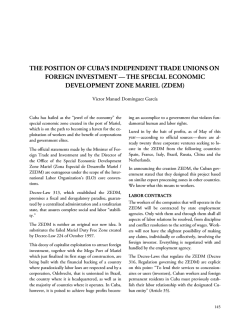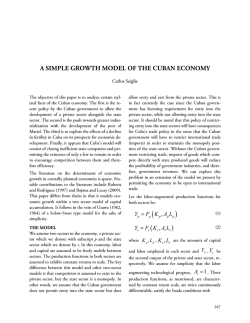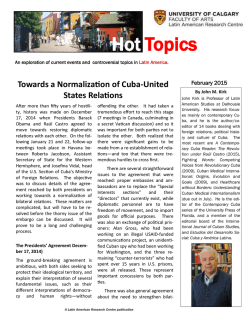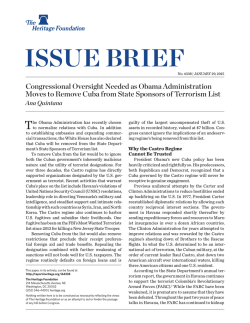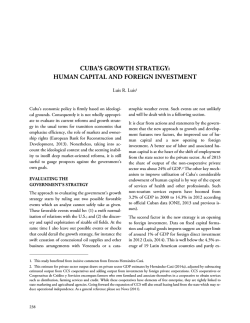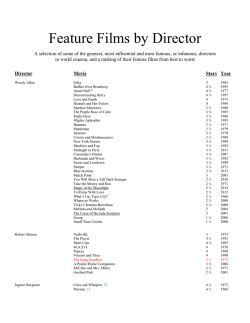
does cuba have a future in manufacturing?
DOES CUBA HAVE A FUTURE IN MANUFACTURING? Archibald R. M. Ritter Cuba has experienced a serious “de-industrialization” from which, by late 2014, it had not recovered. The causes of the collapse are complex and multi-dimensional. The consequences include job and income loss, the loss of an important part of its economic base, the loss of much of the potential for export expansion and diversification, and rust-belt style industrial and urban decay. Cuba risks becoming a typical small Caribbean Island, exporting services and some resources, while importing almost all manufactures. Can Cuba’s manufacturing sector recover from this collapse? What can be done to reverse this situation? Perhaps it should be noted to begin with that in recent years, the manufacturing sectors of many high income countries have shrunk as a proportion of GDP, in absolute terms, and with respect to employment. This has been due to technological change and rising labor productivity in many areas of manufacturing and to the migration of labor-intense manufacturing to lower-wage countries, most notably China and India. However, given Cuba’s income levels and its historical record, it could and should maintain and perhaps expand its manufacturing base and possibly increase employment in the sector rather than remaining in melt-down phase. Despite its contraction, manufacturing continues to be an important part of the Cuban economy. Surprisingly, perhaps, it seems to receive relatively little analytical attention in comparison with other sectors, and does not seem to have been analyzed in as much depth as some other economic areas, notably agriculture.1 THE COLLAPSE OF MANUFACTURING, 1989–2014 By any measure, the collapse of manufacturing since 1989 is severe, as illustrated in Table 1 and Figures 1–3. Table 1. Manufacturing Industry in the Cuban Economy Goods-Producing Components of GDP Manufacturing Value Added as Percentage of GDP (excluding sugar, mining and construction) Agricultural Value Added as Percentage of GDP (excluding sugar) Index of Manufacturing Output in Physical Terms (excluding sugar, mining and construction) [1989 = 100.0] Labor Force Manufacturing as Percentage of Total Agriculture as Percentage of Total 1989 2011 24.7% 13.4% 11.2% 3.7% 100.0 54.3 19.4% 20.9% 10.1% 19.7% Source: ONE, Anuario Estadístico de Cuba (AEC), 2008, 2011 (Table 5.5) and 2013 (Table 7.3); and CEPAL, La Economía de Cuba, Santiago de Chile, 2000. Cuba’s manufacturing sector has been significant in the past. In 1989, the sector (not including construction, utilities and transportation) constituted almost 25% of GDP and employed 19.4% of the labor force. However, by 2011, the sector accounted for only 13.4% of GDP and 10.1% of the labor force, reductions of close to 50% in each case. In comparison, the agricultural sector, not including sugar, ac- 1. However, analysts at the Centro de Estudios de la Economía Cubana (CEEC) in Havana, specifically Ricardo Torres Pérez, have been turning their attention to this area. 345 Cuba in Transition • ASCE 2014 Figure 1. Index of Industrial Output (excluding Sugar) 1989–2012 (1989 = 100.0) Source: ONE, AEC 2004, Table 11.1, AEC 2012; and Cuadro A.90, CEPAL, La Economía Cubana, Santiago de Chile, 2000 counted for 11.2% of GDP in 1989, falling to 3.7% in 2011. Employment in the agricultural sector remained higher, at 19.7% of total, declining only slightly from 1989. Thus the manufacturing sector is about three times the magnitude of agriculture in terms of generation of GDP, though employment in agriculture is almost twice that of manufacturing. The volume of manufacturing production, in physical terms, collapsed with the economic melt-down accompanying the end of the “special relationship with the former Soviet Union” from 1989 to 1992 (see Figure 1). By 1993, it had declined to about one-third of the 1989 level. The volume of production rose somewhat in the following two decades, but by 2012 it was still only 54.3% of the 1989 level (ONEI, AEC 2013, Table 11.1). Production volumes in the sugar agro-industrial sector began a rapid descent from 1991 to 1995. From about 1995 to 2000 they remained in the 3 to 5 million ton per year range, but then declined sharply from 2000 to 2005 to about 1 to 1.5 million tons per year (see Figure 2 for an illustration of the trajectory of the sugar sector after 1985). By 2012, sugar production volumes were around 20% of their 1989 level. If the industrial component of sugar production is included in the index of manufacturing volumes, the 346 2012 volume of production for the consolidated sector was 46.2% of the 1989 level (Ibid). A disaggregated picture of the collapse of the manufacturing sector over the period 1989–2012 is presented in Figure 3. As illustrated there, production volumes for a small number of product categories remained reasonably unchanged, namely tobacco products, drinks (presumably alcoholic), furniture and metal products (non-machinery), whose output in 2012 were approximately at or above their 1989 levels. Pharmaceutical production increased dramatically, with 2012 production reaching 991.4% of the 1989 level, almost a nine-fold increase (Ibid.). Unfortunately virtually every other category of manufactures experienced drastic declines in their volumes of production. Food production in 2012 was at 68.9% of the 1989 volume. Textile and clothing production were 8.1% and 30.8%, respectively, of their 1989 levels. Machinery and equipment, transport equipment, paper products, fertilizers, and wood products were close to disappearing at 0.7%, 3.6%, 8.9%, 7.7% and 9.9%, respectively, of their 1989 volumes in 2012. Statistics on manufacturing by physical volume are also presented by ONE according to their “destinations,” namely consumption, intermediate products and capital equipment. From this perspective, the Does Cuba Have a Future in Manufacturing? Figure 2. Cuban Sugar Production, 1985–2012 Source: CEPAL, La Economía Cubana, Santiago de Chile, 2000 Cuadro A.86; ONE, AEC, 2012 Table 11.3. Figure 3. Changes in Output Volumes in Cuba’s Manufacturing Sub-sectors, 1989-2012 Source: ONE, AEC 2012, Table 11.1. 2012 physical levels of output had declined to 89.2% of the 1989 level for consumer products, to 38.7%, for intermediate products and to 6.9% for capital equipment (ONE, AEC 2012, Table 11.2). 347 Cuba in Transition • ASCE 2014 CAUSAL FACTORS There are a variety of reasons for the collapse of the manufacturing sector after 1989. The initial factor was the termination of the special relationship with the Soviet Union through which the Cuban economy had been subsidized generously since the 1960s. This resulted from the shifting of the Soviet Union to world prices in its trade relations with Cuba (rather than the high prices for Cuba’s sugar exports to the USSR and low prices for petroleum imports from the USSR), as well as an end to the provision of credits and coverage for Cuba’s continuing trade deficits. The break-up of the Soviet Union and recession in Eastern Europe also damaged Cuba’s export markets. With this shrinkage of exports and in the absence of new credits, came reduced imports, especially imported inputs, replacement parts and new machinery and equipment of all sorts. The economic meltdown of 1989–1993 led to a collapse of savings and investment and resulted in cannibalization of some plant and equipment for replacement parts. The end result was a severe incapacitation of the manufacturing sector. Second, the technological inheritance from the Soviet era embodied in machinery and equipment was antiquated and uncompetitive, as became painfully apparent after the opening up of the Soviet economy following Perestroika. Third, since 1989, levels of investment have been continuously insufficient. For example, the overall level of investment in Cuba in 2008 was 10.5% of GDP in comparison with 20.6% for all of Latin America, according to UN ECLA (2011, Table A-4). Maintenance of equipment and re-investment was also de-emphasized even before 1989. After 1989, maintenance and re-investment were deemphasized as they were a category of economic activity that could be postponed during the economic meltdown — for a little while. But over a longer period of time, lack of adequate maintenance of the capital stock has resulted in its serious deterioration or near destruction. This can be seen graphically by the casual observer with the dilapidated state of housing and infrastructure of all sorts in Havana and throughout 348 the country — with the exception of tourist resorts and facilities. Fourth, the dual monetary and exchange rate system penalized traditional and potential new exporters that receive one old peso (Moneda Nacional) or “CUP” for each US dollar earned from exports — while the relevant rate for Cuban citizens was 26 CUP pesos to US$1.00. This made it difficult if not impossible for some exporters to remain financially viable and was a key contributor to the collapse of the sugar sector. Furthermore, the prohibition of private sector enterprise, including most micro, small and medium-scale enterprises for the last 50 years has also blocked a half-century of entrepreneurial initiatives and learning on a trial and error basis. The result is that a diverse range of new manufacturing activities have not emerged for the lack of a private sector. The state sector has not been an adequate replacement for such decentralized and diversified but thwarted endeavors. Finally, China has played a major role in Cuba’s deindustrialization, as it has done with other countries as well. China has major advantages in its manufacturing sector that have permitted its meteoric ascent as a manufacturing power house. These include an industrious labor force; low-cost labor; past and current emphases on human development and higher education; a relatively new industrial capital stock; massive economies of scale; and massive “agglomeration economies.” But of particular significance has been its grossly undervalued exchange rate that has permitted it to incur continuing trade and current account surpluses and amass foreign assets now amounting to around US$3 trillion. Indeed, it can be argued that China has cheated in the globalization process and captured the lion’s share of its benefits through manipulation of its exchange rate. In the process, this has contributed to the generation of major imbalances for the rest of the world, including both the United States and Cuba, among other countries. China’s undervalued exchange rate has coexisted with Cuba’s grossly overvalued exchange rate that has been partly responsible for pricing potential Cuban exports of manufactures out of the international market. The result is that Cuba, like the Unit- Does Cuba Have a Future in Manufacturing? Figure 4. Labor Productivity in Manufacturing (excluding Sugar), 1989–2011 (1989 = 100) Source: The author, based on statistics from ONE, AEC 2013, and CEPAL 2000. ed States, Canada and many other countries, is awash with cheap Chinese products that have replaced consumer products that Cuba formerly — in the 1950s as well as the 1970s — produced for itself. With respect to the sugar sector, there are a number of factors have been responsible for its decline. Most serious, the sector was a “cash cow” milked to death for its foreign exchange earnings, with insufficient maintenance and re-investment steadily impairing productivity. The monetary and exchange rate regimes under which it labored also damaged it badly. Earning one “old peso” for each dollar of sugar exports deprived the sugar sector of the revenues it needed to sustain its operations. Finally, the decision by former President Fidel Castro to shut down almost half of the industrial capacity of the sector sealed the fate of the sugar sector. This decision was foolish in the extreme, in view of Cuba’s natural and historical advantages in sugar cultivation and processing, the sophistication and diversity of the whole sugar agro-industrial cluster of activities, the higher sugar prices of recent years and the competitiveness of ethanol derived from sugar cane. CONSEQUENCES OF THE COLLAPSE OF MANUFACTURING The consequences of the shrinkage of the manufacturing sector are serious. Employment in the sector (including sugar) declined from 685,500 in 1989 to 608,500 in 2012 or, a reduction of 11.2% (ONE AEC, 2013 Table 7.3). Labor productivity in manufacturing has fallen as the volume of output has diminished more rapidly than employment, as illustrated in Figure 4. The 2012 level of output in the manufacturing sector (including sugar) declined by 45.7% from the 1989 level but employment in 2012 had declined by only 11.2% from the 1989 level. This means that labor productivity in manufacturing also declined from 1989 to 2012, though the true magnitude cannot be estimated accurately without knowing the values as well as the volumes of production in these years. Third, the importation of manufactures has risen sharply. Virtually all the shoes, clothing, textiles, household equipment and gadgetry and electronic items are now imported. Indeed, one can purchase most plumbing supplies, electrical materials, dishes, pots and pans, household gadgetry only for “Convertible Pesos” rather than the Moneda Nacional that people actually earn. Paradoxically, visits to the various Tiendas para la Recaudación de Divisas (“TRD”s or former dollar stores), which are the main source of household equipment and gadgetry, furnishings, clothing, footware, plumbing materials, electrical items, etc., in one sense are similar to visits to the major “Big Box” stores such as Walmart or Target in that the vast majority of the items for sale are imported from China. 349 Cuba in Transition • ASCE 2014 Figure 5. The World According to Walmart’s Procurement Purchases Source: John Konrad, “China Trade Charts”. Walmart, Home Depot, Target and their ilk, make their large-scale purchases from China for all their stores in the country, thereby obtaining economies of scale and quantity discounts. Has the ChinaWalmart Alliance helped to de-industrialize the United States? See Figure 5. One wonders if the procurement patterns for the large state store chains in Cuba are not unlike those of Walmart. Does CIMEX, the major retailing conglomerate in Cuba make its purchases in the same way, providing for all its outlets in Cuba with single orders? Is a CIMEX-China Alliance in Cuba echoing the China-Walmart Alliance in the United States and having similar results in avoiding smaller scale procurement purchases from Cuba or other countries? Would CIMEX’s procurement pattern be similar to Walmart’s? A fourth result of Cuba’s de-industrialization is that it has lost much of the foundation on which diversified manufacturing activities could be developed in the future. For example, Cuba has essentially lost the ancillary “clusters” of economic activities that once surrounded the sugar sector specifically, and agriculture generally, producing inputs and processing outputs. Large components of the sugar-related manufacturing sector have shut down — notably the 350 manufacture of cane harvesters and agricultural machinery and equipment as well as the production of replacement parts for the sugar mills. As illustrated in Figure 3, the production of machinery and equipment in 2012 was at 0.4% of the 1989 level while that for metal fabrication was at 32.8%. This situation prevails in other areas of manufacturing as well. Finally, the potential for the emergence of manufacturing for export markets has been impaired. It will be difficult to reconstruct the manufacturing activities for which Cuba might have been able to develop some comparative advantages. THE “LINEAMIENTOS” ON MANUFACTURING The Lineamientos de la Política Económica y Social del Partido y la Revolución, approved on April 18, 2011, by the VI Congress of the Cuban Communist Party include 25 guidelines on Industry. Some of the guidelines are of obvious significance and would be of great usefulness for the revival of manufacturing — if they could be implemented. These include • • • “prioritizing” exports (Guideline No. 215), “prioritizing” maintenance (220), assuring inputs for the self-employment and cooperative sectors (217), Does Cuba Have a Future in Manufacturing? • • emphasizing technical training (132 and 138), the rationalization of industrial capacity, including the sales, rental or usufruct of unused facilities to the self-employed (219). Some specific industrial sectors are designated for future emphasis, including pharmaceuticals (guideline 221), nickel (224), natural medicines and dietary supplements (222), information technology and electronics for export (226), fertilizers (230), rubber tires (231), construction materials (233), and metallurgy and machinery and equipment (234, 236 and 237). Some of these seem reasonable and may have important roles to play in future manufacturing. Elsewhere in the Lineamientos, exchange rate and pricing considerations are mentioned, with the stated intention to move to a unified and realistic exchange rate but with only a modest beginning at implementation as of October 2014. Liberalizing small enterprise and promoting larger co-operative forms of organization are now in process of implementation. For these two sectors, pricing is for the most part supposed to be determined by the forces of supply and demand. This may be an important step in permitting the emergence of new, innovative enterprises. However, the continuing limits on size, the prohibition of professional activities, onerous taxation and other factors all impede the evolution of a diversified range of medium scale enterprises in higher-tech manufacturing and related services. If the proposals of the Lineamientos were implemented fully and quickly, one could envisage the possibility of a turn-around for the manufacturing sector. So far, however, reforms in these areas have been limited and slow. THE RANGE OF POSSIBILITIES What might be the successful manufacturing subsectors in the future? It is of course difficult and perhaps impossible to “pick the winners” in advance. The most efficacious general approach for Cuba would be to establish a reasonable policy and institutional framework and let the winners emerge over time. This would include such policies as unifying the monetary and exchange rate systems, liberalizing small and medium enterprise further, establishing a secure property rights system, consolidating the framework for the impartial rule of law towards enterprises and a fair taxation system for Cuban-owned private sector enterprises. Cuba is in the process of implementation in some of these areas though it still has a distance to go. Assuming that Cuba does establish an “enabling environment” for the development of the manufacturing sector, what might be the manufacturing opportunities for Cuba? This section endeavors to construct a first sketch of Cuba’s main manufacturing sub-sectors and their future potential. Traditional Agro-Industries: Sugar, Tobacco and Rum The volumes of output in the sugar agro-industrial sector fell from around 7 to 8 million metric tons of sugar per year in the 1980s to 1.6 million for the 2014 harvest (Frank, 2014). Perhaps the sector, focusing also on bio-fuels, can be reconstructed although now this would have to be almost from the ground up. Foreign — that is, Brazilian — technology, investment resources, managerial talent and entrepreneurship would be vital in this effort. But the old dysfunctional state enterprise model seems so entrenched that only successful implementation of dramatic institutional change as well as massive investment can bring it about. Cuba has a major comparative advantage in cigars production and a thriving agricultural and manufacturing base for future expansion. Market prospects are mixed but modestly positive on balance. The market for cigars in the high income countries may weaken in future as the baby boomers age further and become more concerned about their health. The cigar fad of the 1990s is unlikely to return in those countries with the same intensity. On the other hand, cigars may become a status symbol for the males of the burgeoning middle classes of the emerging middle income countries of Latin America and Asia. Normalization of relations with the U.S. would also increase demand. Obviously it is worthwhile to continue to promote this sector. It might also be worthwhile to produce — for export — high quality machine-made cigars at prices that are more affordable than hand-rolled cigars for a broader market, be- 351 Cuba in Transition • ASCE 2014 Figure 6. Cuban Exports by Product Shares, 2011 Total: 17,157.1 Million Cuban Pesos Source: ONE, AEC 2011, Table 8.11, 15.11, and 5.17. Note: Exports labeled “Other Manufactures” at CUP 3,240 million or 18.9% of total foreign exchange earnings are neither defined nor identified by ONE. It is likely that they include the re-exportation of petroleum imported from Venezuela, among other items. (See Mesa-Lago and Pérez-López, 2013. Pp. 82–83.) cause Cuba has priced itself out of the middle class or middle-range cigar market. The market for rum and alcoholic beverages has been strong. Its future should also be positive again due to increasing demand in emerging countries and the United States after normalization. Food Processing Cuba should have great potential in processing agricultural products. However, this depends on a thriving agricultural sector providing the raw materials. Unfortunately, Cuban agriculture has been in decline, especially since 1990. Some past exports, such as citrus fruits, have virtually fallen out of the picture. Cuba could have significant production for export markets of raw or semi-processed citrus products, tropical fruits and vegetables. This would require major expansion of food production and is thus only a longer-term possibility at this time. However, a diversified range of agro-industrial activities could be considered, e.g., mango cultivation and juicing for export markets.2 This of course would have to be part of an agricultural revival, and would require a general enabling environment for agricultural and industrial enterprise. Pharmaceuticals This sector has been dramatically successful since 1989. Exports to a broadening range of countries accounted for 546 million pesos in 2011, second only to nickel within merchandise exports (see Figure 6). This success should continue into the future. However there are downside risks. First, new drugs must continuously be developed because generic versions of existing drugs can be produced freely anywhere (for example in India and China) when patent protection runs out — if not before. This means that Cuba’s producers, like big pharmaceutical companies, face eventual death unless they innovate and patent successfully. Second, some of the markets for Cuba’s pharmaceuticals are of an ideological “sweetheart” character, e.g., purchases by Venezuela. These may be at risk in the longer term when the CubaVenezuela “special relationship” runs its course. 2. For example, Canada imports growing volumes of several varieties of mango juice from the Republic of South Africa. Cuba could share in such markets. Again, normalization of relations with the United States in time will be of benefit in providing a very large nearby market. 352 Does Cuba Have a Future in Manufacturing? Light Manufactures Some of the lines of production that have declined most seriously — by 70% to 90% depending on the product line — are footwear, textiles, clothing, and consumer products of leather, wood, paper, metal, rubber and plastic for household use (see Figure 3). This is tragic when one considers that even in the 1940s, Cuba was a major producer of a range of products such as leather and rubber shoes, cotton and rayon textiles, rubber tires, soap, paint, clothing, etc. (IBRD, 1950, p.130.) The collapse of much of Cuba’s light industry is paralleled by its corresponding contraction in Canada and the United States. It would be difficult for Cuba to reclaim many of these areas, given the major economies of scale and agglomerative economies that big countries such as China, India, and other Asian countries experience. One can imagine niche-type markets in which Cuba could have some success. For example, the manufacture of some lines of specialty women’s clothing, leather footwear, and Spanish-colonial style furniture might be possibilities. Already one sees surprising crafts-level innovation in a myriad of areas, focusing on hard-currency tourist markets. These provide some hope that middle-sized enterprises could emerge and develop new products for Cuban and foreign markets. But for this to happen, there would have to be the possibility that micro-enterprises could evolve into small and medium scale firms. This is still blocked — with the possible exception of cooperative forms of enterprises. Chemical and Petrochemical Products If Cuba emerges as a significant petroleum producer or refiner of imported petroleum, it is possible that it may develop a range of petrochemical products for national and regional markets. Some production and exports are likely to emerge from the new refinery complex in Cienfuegos. However, the competition in the region from established producers in the region such as the US gulf coast, Mexico, Trinidad and Venezuela is serious so the possibilities here seem limited. Could the production or “mixing” of fertilizers — from imported potash, phosphates and nitrogen — be revived for domestic and foreign markets? Per- haps, though Cuba has no particular advantage in this area. Heavy Industry and Capital Goods Production Heavy industry such as an iron and steel complex, metal fabrication, wire and tube making is unlikely to emerge in a significant way in Cuba due to lack of cheap energy sources at this time, the absence of relevant raw materials, absence of significant metal-using industries within Cuba, the small domestic market vis-à-vis efficient scales of production and the absence of relevant skills. This situation could change somewhat in future if low-cost sources of energy from off-shore petroleum were to be developed. Machinery and Equipment Cuba has produced some agricultural transport equipment, cane carts for example, since early colonial times. More recently, it produced sugar cane harvesters and a wide variety of tanks and vats and simple equipment for sugar mills. At this time, Cuba has lost most of the domestic market for the production of such machinery and equipment. Brazil seems likely to capture much of this market in the future as it is already a major producer of machinery and equipment for its own large sugar sector. However, there may be some niche products that could emerge. Chances for Cuba of breaking into the production of automotive parts, plastic and glass materials, instrumentation, batteries, rubber tires, etc., seem slim in the foreseeable future. Automotive assembly also would seem to be out of the question given the lack of the relevant cluster of economic activities on which these would be based and the great economies of scale that other established producers elsewhere possess. Despite this, there has been some discussion of the assembly of automobiles, basically from “kits,” in the Mariel Export Processing Zone. The tax advantages of operating in Mariel may make such assembly profitable although the economic fundamentals for such a venture are dubious. Generally speaking, the production of complex machinery and equipment in Cuba would be economically unviable in view of the small domestic market, the lack of relevant locally-available inputs, and the absence of relevant skills. On the other hand, there is a broad range of simple capital goods such as tanks, 353 Cuba in Transition • ASCE 2014 bins, vats, reinforcing bar, and custom-built one-off sheet-iron type products for which transport costs are high and small production volumes are the norm. These could be viable in future. Electric and Electronic Equipment The assembly of some electric or electronic products occurs now in a minor way and could perhaps be expanded. However, virtually all of the components have to be imported so that domestic value added is limited. Again, competition from abroad, notably from China, is difficult to overcome due to its huge advantages as noted earlier. To be sure, China could locate some assembly operations in Mariel if the tax arrangements are considered to be sufficiently generous. The Mariel Export Processing Zone (EPZ) The Mariel EPZ creates some new possibilities for Cuba. It is possible that China (wooed by Cuba with a “Mariel mission” that visited that country in September 2013), Brazil (the financier and constructor of the Mariel EPZ) and possibly other countries could establish assembly, light fabrication or bulkbreaking activities in the EPZ (Frank, 2013). This is certainly the purpose of the tax treatment provided to foreign investors. This includes a ten-year holiday from paying a tax on profits and full expatriation of profits; a 12% levy after 10 years; the normal Cuban income tax rate for foreign workers; a 14% (of wage) payment for workers’ social security; zero tax on imported machinery and equipment and raw material inputs; a zero property and municipal tax rate and a 0.5% fee for maintenance and development of the EPZ (Ritter, 2013). One can imagine special arrangements between China and Cuba regarding Chinese investment projects in Mariel. Though China has been strongly commercially oriented in many of its international economic inter-relationships, it has also provided generous economic assistance to many countries, notably in Africa, which are perceived to have longer-term beneficial implications for China’s influence in that country and the world. Cuba could be the beneficiary of such largesse. This tax regime in itself will not generate a huge amount of foreign exchange revenues for the Cuban 354 Government from the economic activities in the Mariel EPZ — unless of course there is a massive volume of direct foreign investment in the EPZ. The tax provisions should provide some incentive for foreign firms to locate in the EPZ, but, as Jorge Pérez-López (2014) has argued, these are not far out of line with those offered by other countries for operators in their EPZs, so that there may be little net advantage for investing in Mariel. Some other terms and conditions of operation in Mariel for foreign enterprises would seem have a positive incentive effect, for example, 50 year contracts for investment. But other provisions may have — or continue to have — a negative incentive impact. This is likely the case with the continuing control over the hiring of workers by a government office, rather than by the foreign enterprises themselves. ESTABLISHING A GENERAL POLICY ENVIRONMENT FOR THE PROMOTION OF MANUFACTURING To revive Cuba’s manufacturing sector will be difficult. The loss of so much industrial capacity since 1989 has weakened the foundation on which such a recovery could be based. There are some promising sectors, most notably pharmaceuticals, cigars, rum, food products, and, one hopes, some niche fabrication activities. But other sub-sectors appear to be unpromising. What is needed is a set of policy reforms that would establish an “enabling environment” for enterprise development and for the promotion of manufacturing for the domestic market and exports. Central among such policy reforms would be the further liberalization of small and medium enterprise, the establishment of a reasonable tax regimen for Cuban private sector enterprises and the successful reform of the monetary and exchange rate systems. Some of this was recognized in the Lineamientos. But there is still some distance to go. Reform of the Policy Framework for Private Enterprise By September 2014, Cuba had undertaken a series of significant reforms of the policy framework shaping micro-enterprise. This led to a major expansion of employment in micro-enterprise, which had reached Does Cuba Have a Future in Manufacturing? 471,000 persons in total by July 2014. There are variety of additional initiatives that would help to establish a policy environment which would approach the international norm. Among these would be the following: • • • • • • • • Permission for the employment perhaps of 50 employees in all areas of activity; Permission for all areas for enterprise — beyond the current 201 — including permission for the establishment of professional enterprises; Open, timely and automatic licensing for all who wanted to establish an enterprise, letting competition determine which survived (and also putting downward pressure on prices, upward pressure on quality, and creating pressure for a merging of average incomes in the private and public sectors); Implement wholesale markets for domestic and imported inputs:; Provide open access to foreign exchange and imported inputs under reasonable terms that would be the same as those for the public and cooperative sectors: Establish effective micro-credit and credit facilities: Permit the establishment and operation of “intermediary” enterprises in marketing; Permit advertising. With a more reasonable policy environment for micro, small and, in time, medium-scale enterprise, the creativity, industriousness and entrepreneurship of many Cuban citizens — already demonstrated with the rapid expansion of micro-enterprise following the liberalization measures of 2011 — should lead to further enterprise development in manufacturing activities and an expansion of the sector and employment therein. This would be strengthened further of course with the normalization of economic relations with the United States in trade, direct investment, technological flows, and financial flows. Deeper co-operation between Cuban, Cuban-American and other American citizens with respect to trade, investment, and entrepreneurial endeavors would be of considerable benefit to the development of Cuba’s manufacturing sector — as well as other sectors. Taxation of Small Enterprise In mid-2014, the tax regime facing small enterprise was exceedingly onerous. There also was a disturbing bias in the regimen favoring foreign enterprise relative to Cuban-owned small private enterprises. The sum of the income tax, employee hiring tax, and public service surtax is high and, together with the rules on deduction of input and investment costs from gross income in determining taxable income, can generate effective tax rates exceeding 100% (see Ritter and Henken, 2014, Chapter 5 for an explanation of this situation).3 The most serious shortcoming of the income tax regime involves the tax base, which is not “net revenues” after the deduction of input and investment costs, but various arbitrary proportions of total revenues, depending on the activity involved. The tax regime limits the maximum for input costs deductible from total revenues to 10% to 40% depending on the type of enterprise involved. When the actual microenterprise input costs exceed the maximum allowable, the effective tax rate on true net income can become very high. The discrimination versus small private Cuban enterprises vis-à-vis foreign enterprises operating in joint ventures with state enterprises is summarized in Table 2. The chief differences are the following: (a) foreign enterprises receive a tax holiday for eight years while Cuban enterprises do not; (b) for foreign firms, all investment and input costs are deductible from gross income in determining taxable income while Cuban enterprise face arbitrary limits of 10% to 40%; (c) profits taxes for foreign enterprises are 15% of net corporate income (50% for resources) while Cuban enterprises pay 50% income tax on income exceeding CUC 2000.00 per year. 3. This will continue to promote non-compliance. It will also discourage underground enterprises from becoming legal and the establishment of new enterprises. 355 Cuba in Transition • ASCE 2014 Table 2. Comparison of the Tax Regimes for Small Enterprise and Foreign Mixed Enterprise after the 2014 Foreign Investment Law Nominal Tax Rates Small Enterprise Personal Income Tax Rate: 15% up to 50% of income above CUP 2000 per year Foreign Investors Profits Tax: 15% of Net Corporate Income (50% for resources); Effective Tax Base 60 to 90% of Gross Revenues (Maximum of 10% to 40% allowable depending on activity) Net Income after deduction of all production and investment costs from Gross Revenues Effective Tax Rates Tax Holiday May exceed 100% of Net Income None 15% of Net Income Eight Years Tax Exemption Deductibility of Input and Investment Costs from Gross Revenues Deductible only within the 10% to 40% limits Fully deductible from Gross Revenues Employee Hiring Tax Exemption for first five employees; with six or more employees the tax is incurred Complete Tax Exemption Social Security Payments Lump-Sum Taxation Profit Expatriation Yes Up-front Cuota Fija No Yes None Yes Source: Ritter and Henken, 2014, Chapter 5, Monetary and Exchange Rate System. Some relaxation of the heavy tax burdens for Cuban small enterprise and the elimination of the discriminatory tax treatment they face would provide a major impetus for the further expansion of employment in the small enterprise sector. After more than 20 years of analyzing the problem, Cuba is now committed, through the Lineamientos, to unifying the dual monetary and exchange rate systems and began the process in 2014. If this means establishing a market-determined exchange rate — which may or may not be the case — this should lead to the convertibility of the currency and a significant devaluation of the CUP or Moneda Nacional. The impacts of devaluation and convertibility on the manufacturing sector would, in time, be positive. Imported manufactures would rise in price with a devaluation and Cuban products would become more competitive domestically and internationally. Potential exports of Cuban manufactured products would decline in price, making them more internationally competitive, thereby stimulating an expansion of international markets. In this process, new opportunities for manufacturers would emerge. If the policy environment was appropriate, such opportunities could increasingly be seized. CONCLUSION Does Cuba have a future in manufacturing? 356 There are some general comparative advantages as well as disadvantages for manufacturing that Cuba is facing as of mid-2014. First, the comparative disadvantages: • • • • • • • Cuba’s manufacturing base has collapsed significantly; Its capital stock and infrastructure generally is badly decayed and obsolete after many decades of under-investment; Low investment levels impede up-grading the capital stock in all areas; Human skills relevant for manufacturing are also badly decayed, mis-fitted and obsolete; Cuba’s domestic market size with limited effective demand is limited due to its small and shrinking population of about 11 million together with relatively low real income levels; Agglomerative and scale economies are minimal; The U.S. embargo blocks potential exports, financial inflows, investment, flows of skilled people, and technological transfer of various sorts. But Cuba also has some important general comparative advantages that could bear fruit in the future. These would include the following: • Cuba’s citizens are well-educated in formal terms with a strong foundation and incentive for further learning; Does Cuba Have a Future in Manufacturing? • • • • Many Cuban citizens are energetic, creative, and entrepreneurial; Cuba has a number of established manufacturing sub-sectors that are strong, such as pharmaceutical products and traditional products (beverages and tobacco); Cuba has major potential in some agriculturalbased products, namely fruits and vegetables, as well as nickel; In the future — hopefully the near-future — Cuba will be able to capitalize on its major locational advantage with respect to the US market, which could become highly important following the normalization of the economic relationship between the two countries. Finally there is high potential for the development of a symbiotic and complementary relationship between Cubans on the Island and the Cuban-American community, which will stimulate and facilitate the future development of economic activities in many areas, including some manufacturing. So, does Cuba have a future in manufacturing? The answer is “Yes, to some degree” — if policy reforms are significant and expeditious regarding further enterprise liberalization and taxation and if successful monetary and exchange rate reform lead to currency convertibility. A broad-based industrial revival for Cuba is possible but will be difficult. BIBLIOGRAPHY Frank, Marc, “Cuba bids to lure foreign investment with new port and trade zone,” Reuters, September 23, 2013. Frank, Marc, “Cuban sugar output tops previous harvest, but well below plan,” Reuters, May 19, 2014. Comisión Económica para América Latina y el Caribe (CEPAL), La Economía de Cuba, Reformas estructurales y desempeño en los noventa. Santiago de Chile, 2000. International Bank for Reconstruction and Development, Report on Cuba, Washington D.C.: IBRD, 1950. Konrad, John, “China Trade Charts,” Captain, www. http://gcaptain.com/top-3-china-tradecharts/, July 19, 2007, Accessed October 2, 2014. Mesa-Lago, Carmelo, and Jorge Pérez-López, 2013, Cuba under Raul Castro: Assessing the Reforms, Boulder, Colorado: Lynne Rienner Publishers, 2013. Oficina Nacional de Estadísticas (ONE), Anuario Estadístico de Cuba, 2012. Partido Comunista de Cuba. 2011. VI Congreso. Lineamientos de la Política Económica y Social del Partido y la Revolución. Havana. April. Pérez-López, Jorge, “Investment Incentives of the ZED Mariel: Will Foreign Investors Take the Bait?,” Cuba in Transition — Volume 24, Association for the Study of the Cuban Economy (ASCE), 2014. Ritter, Archibald R. M., “The Tax Regimen for the Mariel Export Processing Zone,” www.thecubaneconomy. 26 September 2013. Ritter Archibald R. M. and Ted Henken, Entrepreneurial Cuba: The Changing Policy Landscape, Boulder Colorado: Lynn Rienner Publishers, 2014. 357
© Copyright 2026
